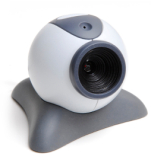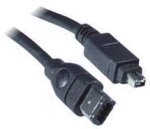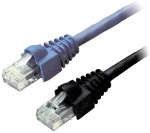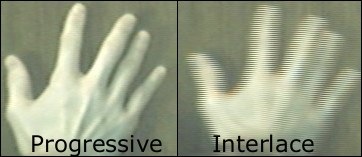 January 2008
January 2008
Introduction
to video capture and
Motion Detection
by Joe Janson,
Project Lead,
Omega Unfold inc
Motion Detection
by Joe Janson,
Project Lead,
Omega Unfold inc
 January 2008 January 2008
Introduction
to video capture and
Motion Detection by Joe Janson, Project Lead, Omega Unfold inc |
|
I have a motion detection project,
what do I need to know? A motion detector systems can give your PC eyes, letting it respond to external events by capturing images, or triggering actions. However, there’s a bewildering array of possible set ups, not all of them useful to you. You need to carefully identify  your needs, and then get tools
that are good enough without being too much... overkill can kill your
budget! your needs, and then get tools
that are good enough without being too much... overkill can kill your
budget!You'll require both hardware and software. You’ll also need advice, because motion detection and video capture are still emerging technologies and might not be as "plug & play" as you would like. Hopefully, the following will help you get started…. "I need my
computer to be able to see...
really see, not just act like a glorified VCR." What does motion detection software do? Motion detection software captures video from an input device and processes this video in real-time to find significant changes between frames. How it responds to these changes depends on what you’ve programmed it to do. Historically, most serve complex security systems and require special equipment. However, general purpose motion detection software like Zone Trigger is now available. General purpose motion detection is intended for the ordinary users and moves motion detection away from its original security context, bringing it to new places where it can be used to interact with people, automate processes, and replace costly custom hardware with simple non-intrusive monitoring. For example, the following applications show how general motion capture can reduce costs, increase quality or enable something that wasn't possible before:
Good general purpose motion detection software should let you determine exactly what kind of motion to look for and then permit a range of responses, e.g. taking pictures, recording videos and sending e-mail notifications. The best software should also be able to analyse the movement itself. Typical operations include:
Scientists
and animators also use software that supports motion
tracking in a controlled environment. Future advances in
hardware and
software may make this viable “in the wild”, along with routine gesture
recognition - something with a myriad of possible
applications.
What kinds of cameras work for motion detection? USB cameras (“webcams”)  USB
cameras, usually called
“webcams”, are the quick and dirty solution
to hooking a camera to your PC. All you need is the supplied
driver software, so you can be up and running in minutes. Better yet,
USB cameras are Direct-X compatible and work with almost any video
capture software. USB
cameras, usually called
“webcams”, are the quick and dirty solution
to hooking a camera to your PC. All you need is the supplied
driver software, so you can be up and running in minutes. Better yet,
USB cameras are Direct-X compatible and work with almost any video
capture software.However, there are snags. Though you can connect lots of webcams to a single computer, they’re more or less limited to arm’s reach because a USB cable is not designed for distance. More importantly, USB cameras vary in quality. Cheap ones don’t always provide clear or accurate images. Artefacts (visible defects) include motion blur and oddness caused by compressing the image before sending it to your PC. Some also do badly in poor light conditions, providing poor images and a low frame rate. The good news is that some good quality USB cameras have a high resolution and fast frame rate video. Some even come with zoom lenses. The price of the camera is your first clue about the quality of its images. DV cameras (“camcorders”)  DV
cameras – the DV stands for
“Digital Video” - are the high-end
solution. Often called “camcorders”, these provide awesome image
quality and a fast frame-rate. They are almost always equipped with a
zoom, and may have nice features such as night-vision.
Compatible
with Direct-X, they should
work with most any recent video capture software. DV
cameras – the DV stands for
“Digital Video” - are the high-end
solution. Often called “camcorders”, these provide awesome image
quality and a fast frame-rate. They are almost always equipped with a
zoom, and may have nice features such as night-vision.
Compatible
with Direct-X, they should
work with most any recent video capture software. Like USB cameras, DV cameras are tied to your PC by cable length, this time Fire-Wire (IEEE 1394). However, the main downside is that they’re expensive. IP cameras (“network cameras”)  IP cameras, often
known as “network
cameras”, are more complex
remote-controlled devices that connect to a network instead of directly
to your PC. Since they are digital, some can supply very
high-resolution images. IP cameras, often
known as “network
cameras”, are more complex
remote-controlled devices that connect to a network instead of directly
to your PC. Since they are digital, some can supply very
high-resolution images.IP cameras are not physically tied to your PC since they can broadcast video over a local network (CCTV) or the Internet. Most have embedded web-servers, and some have internal motion-detection systems. You can also find wireless IP cams that will connect directly to your Wifi network. Network cameras can be expensive, costing about the same as camcorders. Usually lacking Direct-X drivers, they rarely work with motion detection software unless it specifically supports them. Analogue cameras  Analogue cameras
belong to a whole
different world. They are fast,
provide images with no compression, no artefacts, no motion blur, and
use any cable length you need. They may be equipped with a zoom or
infra-red vision. Some are even “wireless” (but watch the quality,
since local interference might compromise motion detection). Analogue cameras
belong to a whole
different world. They are fast,
provide images with no compression, no artefacts, no motion blur, and
use any cable length you need. They may be equipped with a zoom or
infra-red vision. Some are even “wireless” (but watch the quality,
since local interference might compromise motion detection). The downside of analogue cameras is that they are complicated and resource-intensive. Connecting one to a PC requires video capture hardware. In operation, this can hog the system resources, so your PC probably might not be able to do anything else! Many analogue cameras produce interlaced images, requiring special – often 3rd party – software filters, which may introduce artefacts or reduce picture quality. Overall, using an analogue camera requires a more powerful computer than a standard USB camera would.  The compatibility of the motion detection software is dependent on the video capture device. Here are a few capture device types:
What are good conditions for motion detection? In the best conditions you must have the following:
What is Zone Trigger, and what can it bring to my project? The Zone Trigger product family is all about enabling anyone to incorporate motion or sound detection in their custom projects. The Zone Trigger softwares can be downloaded and installed in a few seconds. It’s so simple to use that you can set up a custom system within a matter of minutes. On detecting motion, Zone Trigger can do almost anything: play sounds, run programs or commands, take control of other software, send email and files over the internet. Plus it has many extra features such as an HTTP server and archive services. Zone Trigger saves you time, money and effort:
Good luck with your project! References http://www.zonetrigger.com - Motion Detection software download site, download a trial copy of the Zone Trigger software. http://www.webcam-project.com - Tips and examples for motion detection projects If you have questions about the Zone Trigger products or if you require consultation and advice on your computer vision projects, please contact Omega Unfold's technical support: support@zonetrigger.com |
